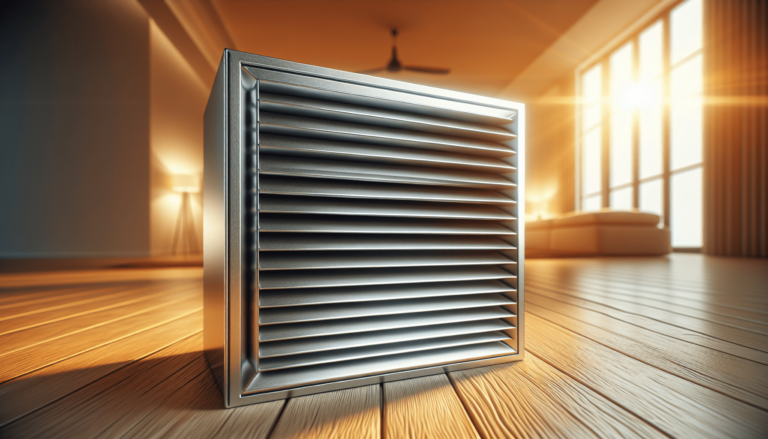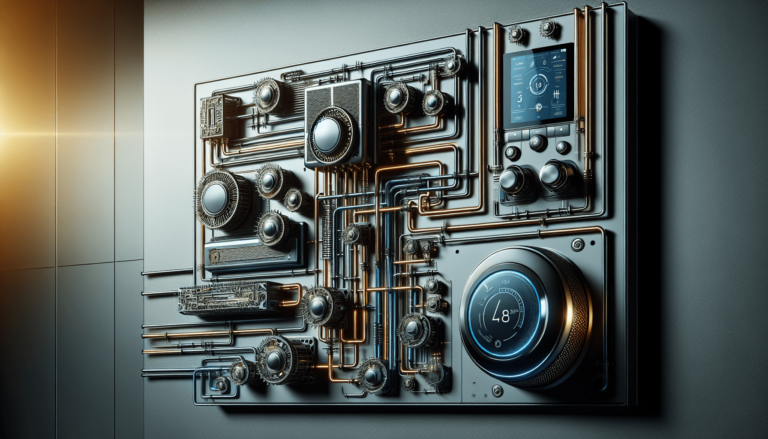

HVAC Services
Get Professional Repairs From The Area's Trusted HVAC Technicians. Ask About Our Services! We Offer Professional Heating & Cooling System Repairs And Guarantee Long-Lasting Results.
Got Question? Call us: (850) 678-2665Financing
The Role Of HVAC In Reducing Allergens Indoors
Discover the role of HVAC systems in reducing allergens indoors. Learn how effective air filtration, humidity control, and ventilation create a healthier environment. Contact Tempacure Heating and Air Conditioning for top-notch services in Niceville, FL.

In the quest for a clean and healthy indoor environment, the role of HVAC systems in reducing allergens cannot be underestimated. With allergens such as dust, pollen, and pet dander posing a threat to those with allergies or respiratory conditions, it becomes crucial to maintain a reliable HVAC system. By effectively filtering the air, controlling humidity levels, and providing ventilation, HVAC systems play a vital role in creating a comfortable and allergen-free environment for you and your loved ones. Tempacure Heating and Air Conditioning, located at 325 Cedar Ave S Suite B, Niceville, FL 32578, understands the importance of a well-functioning HVAC system in reducing indoor allergens and is dedicated to providing top-notch services to enhance the air quality in your home or office. Contact them at (850) 678-2665 or visit their website at https://tempacurehvac.com/ to learn more about how they can help you create a healthier space for you and your family.
The Importance of HVAC Systems in Indoor Air Quality
Indoor air quality plays a crucial role in the health and well-being of individuals, and HVAC systems play a significant role in maintaining clean and allergen-free indoor air. In this article, we will explore the relationship between HVAC systems and allergens, the impact of poor indoor air quality on allergies, and how HVAC systems can help reduce allergens. By understanding these aspects, you can make informed decisions about your HVAC system to create a healthier and more comfortable living environment.
The Relationship Between HVAC Systems and Allergens
HVAC systems, or Heating, Ventilation, and Air Conditioning systems, are responsible for regulating the temperature, humidity, and airflow in indoor spaces. However, they also have a direct impact on the presence of allergens such as dust mites, pet dander, pollen, and mold spores. HVAC systems interact with these allergens in several ways, including filtration, ventilation, and humidity control.
The Impact of Poor Indoor Air Quality on Allergies
Poor indoor air quality can have a significant impact on individuals who suffer from allergies. Allergens present in the air can trigger allergic reactions, leading to symptoms such as sneezing, coughing, itchy eyes, and respiratory discomfort. Prolonged exposure to allergens can exacerbate existing allergies and even contribute to the development of new allergies in individuals who were previously unaffected. Therefore, it is essential to address indoor air quality concerns to create a healthy and allergy-friendly environment.
How HVAC Systems Can Help Reduce Allergens
HVAC systems can play a crucial role in reducing allergens by implementing various strategies. Some of the key approaches include filtration systems, regular maintenance, humidity control, proper ventilation, sealing and insulation, UV germicidal lights, air purifiers, ionizers, energy efficiency considerations, and education and awareness.
Filtration Systems
The Role of HVAC Filters in Allergen Removal
HVAC filters are designed to capture and remove airborne particles, including allergens. These filters act as a barrier, preventing allergens from circulating in the indoor air and reducing the overall concentration of allergens in the living space. By trapping and retaining allergens, HVAC filters help improve indoor air quality and provide relief to individuals with allergies.
Types of HVAC Filters
There are different types of HVAC filters available, each with varying effectiveness in capturing allergens. Some common types of filters include fiberglass filters, pleated filters, electrostatic filters, and high-efficiency particulate air (HEPA) filters. Fiberglass filters are the most basic type and provide minimal allergen removal, while pleated filters offer better filtration efficiency. Electrostatic filters use an electric charge to attract and trap particles, including allergens. HEPA filters, regarded as the gold standard in air filtration, have the highest efficiency in capturing extremely small particles, including most allergens.
Choosing the Right Filter for Allergen Reduction
To effectively reduce allergens, it is important to choose the right HVAC filter. Consider factors such as the specific allergens that need to be removed, the MERV (Minimum Efficiency Reporting Value) rating of the filter, and the compatibility of the filter with your HVAC system. Higher MERV ratings indicate better filtration efficiency, but it is essential to check if the filter is appropriate for your HVAC system’s airflow capacity. Consulting with HVAC professionals can help you determine the most suitable filter for your needs.
Regular Maintenance
The Significance of Regular HVAC Maintenance
Regular HVAC maintenance is crucial for ensuring optimal performance and reducing allergens indoors. Neglected HVAC systems can become breeding grounds for allergens, as dust, mold, and other contaminants accumulate in the system. Maintenance activities such as cleaning, filter replacement, and duct cleaning help eliminate these potential sources of allergens, ensuring cleaner and healthier indoor air.
Cleaning and Changing Filters
Cleaning and changing HVAC filters on a regular basis is essential for allergen reduction. As filters become clogged with dust and debris, their efficiency in capturing allergens decreases. Regularly cleaning or replacing filters helps maintain their effectiveness in removing allergens from the indoor air. It is recommended to follow the manufacturer’s guidelines or consult with HVAC professionals to determine the appropriate frequency for filter cleaning or replacement.
Duct Cleaning
Duct cleaning is another crucial aspect of regular HVAC maintenance that contributes to allergen reduction. Over time, dust, pet dander, mold, and other allergens can accumulate in the ductwork, resulting in the circulation of polluted air throughout the space. Professional duct cleaning, which involves thorough cleaning of the ducts and removal of accumulated debris, helps eliminate these hidden allergen sources, improving the overall indoor air quality.
Humidity Control
The Connection Between Humidity and Allergens
humidity levels in the indoor environment can directly impact the presence and growth of allergens. High humidity can create favorable conditions for mold growth, while low humidity can lead to the proliferation of dry and itchy skin, and respiratory discomfort. Maintaining proper humidity levels is crucial for controlling allergens and creating a comfortable living environment.
The Role of HVAC Systems in Humidity Control
HVAC systems play a vital role in humidity control, helping to regulate and maintain optimal humidity levels. Through the use of components such as humidifiers and dehumidifiers, HVAC systems can increase or decrease humidity levels as needed. By controlling humidity, HVAC systems can inhibit the growth of mold and other allergens, reducing the likelihood of allergic reactions and improving indoor air quality.
Benefits of Proper Humidity Control
Proper humidity control offers several benefits in terms of allergen reduction and overall comfort. By maintaining optimal humidity levels, HVAC systems can prevent mold growth, reduce dust mite populations, alleviate dryness and irritation of the respiratory system, and minimize the occurrence of allergic reactions. Additionally, maintaining balanced humidity levels can enhance the efficiency and longevity of HVAC equipment, contributing to energy savings and reducing maintenance costs.
Ventilation
Importance of Proper Ventilation in Reducing Allergens
Proper ventilation is essential for reducing allergens, ensuring the circulation of fresh outdoor air and the removal of indoor pollutants. Adequate ventilation prevents the buildup of allergens, odors, and other airborne contaminants, promoting cleaner and healthier indoor air. HVAC systems play a crucial role in providing sufficient ventilation and maintaining the optimal balance of indoor and outdoor air.
How HVAC Systems Ensure Sufficient Ventilation
HVAC systems incorporate ventilation components such as air vents, fans, and air exchangers to ensure sufficient airflow and proper ventilation. Air vents and fans facilitate the exchange of indoor and outdoor air, minimizing the concentration of allergens and enhancing air quality. Air exchangers, also known as heat recovery ventilators (HRVs) or energy recovery ventilators (ERVs), further enhance ventilation by exchanging stale indoor air with fresh outdoor air while minimizing energy loss.
The Role of Air Exchangers
Air exchangers, such as HRVs and ERVs, are integral components of HVAC systems that contribute to allergen reduction. These devices transfer heat and moisture between the incoming and outgoing air streams, allowing for ventilation without significant energy loss. By exhaust allergen-laden indoor air and bringing in fresh outdoor air, air exchangers effectively reduce allergen levels and create a healthier indoor environment.
Sealing and Insulation
The Impact of Air Leaks on Allergens
Air leaks in the building envelope can contribute to the infiltration of outdoor allergens, compromising indoor air quality. These leaks provide pathways for pollen, dust, and other allergens to enter the space, increasing the concentration of allergens indoors. Proper sealing and insulation are essential for reducing air leaks and preventing allergen infiltration.
The Role of HVAC Systems in Sealing and Insulation
HVAC systems can contribute to sealing and insulation efforts, thereby reducing allergen infiltration. Ensuring that HVAC ductwork and system components are properly sealed minimizes the potential for air leaks, preventing the entry of outdoor allergens. Additionally, well-insulated HVAC systems can maintain consistent indoor temperatures, preventing condensation and inhibiting mold growth.
Weatherization and Duct Sealing
Weatherization, which involves sealing gaps, cracks, and other air leakage points in the building envelope, is an effective method for allergen reduction. By partnering with HVAC professionals, homeowners can identify and address areas of concern, ensuring comprehensive sealing and insulation. Duct sealing is another critical aspect that helps prevent allergen infiltration, ensuring that conditioned air does not escape through leaky ducts.
UV Germicidal Lights
How UV Germicidal Lights Help Reduce Allergens
UV germicidal lights, also known as UV-C lights, are a technology utilized by HVAC systems to reduce allergens effectively. These lights emit ultraviolet radiation that kills or inactivates bacteria, viruses, molds, and other microorganisms present in the air. By targeting and neutralizing allergen sources, UV germicidal lights contribute to improved indoor air quality and allergen reduction.
Installation and Operation of UV Lights
UV germicidal lights are typically installed within the HVAC system, near the evaporation coil or air handler, to ensure maximum exposure to the air stream. HVAC professionals should handle the installation process to ensure proper positioning and safety. Once installed, the lights operate continuously or in tandem with the HVAC system’s fan, providing ongoing allergen control without the need for manual intervention.
Effectiveness of UV Lights in Allergen Reduction
UV germicidal lights have shown significant effectiveness in reducing allergens and improving indoor air quality. Studies have demonstrated that UV light exposure can lead to a substantial reduction in mold spores, bacteria, and viruses, resulting in a cleaner and healthier indoor environment. However, it is important to note that UV lights may not be effective against airborne allergens that are not microorganisms, such as pollen or dust mites.
Air Purifiers and Ionizers
The Role of Air Purifiers and Ionizers in Allergen Reduction
Air purifiers and ionizers are additional tools that can aid in allergen reduction and enhance indoor air quality. Air purifiers work by trapping and removing airborne particles, including allergens, through the use of filters or electrostatic precipitation. Ionizers release negatively charged ions into the air, causing allergens and other particles to cluster together and fall out of the air, reducing their presence.
Different Types of Air Purifiers and Ionizers
There are several types of air purifiers and ionizers available, each employing different technologies to capture or remove allergens. Some common types include HEPA air purifiers, activated carbon filters, electrostatic precipitators, and ozone generators. HEPA air purifiers are highly effective in capturing microscopic particles, while activated carbon filters specialize in the removal of odors and volatile organic compounds. Electrostatic precipitators use an electric charge to trap particles, and ozone generators release ozone, which can neutralize odors but must be used with caution.
Benefits and Limitations of Air Purifiers and Ionizers
Air purifiers and ionizers offer various benefits in reducing allergens and improving indoor air quality. These devices can effectively remove airborne particles, including allergens such as dust, pollen, and pet dander, resulting in cleaner and healthier air. Air purifiers with HEPA filters have been proven to be highly effective in capturing allergens. However, it is important to note that some ionizers produce small amounts of ozone, which can be a lung irritant in high concentrations. It is crucial to choose reputable brands and follow manufacturer guidelines to maximize the benefits and minimize any potential risks.
Energy Efficiency Considerations
The Connection Between Energy Efficiency and Allergen Reduction
Energy-efficient HVAC systems not only reduce energy consumption but also contribute to allergen reduction. Energy-efficient systems are designed to operate optimally, ensuring proper airflow and air filtration, which results in better indoor air quality. By investing in energy-efficient HVAC systems, homeowners can enjoy both cost savings and improved indoor air quality.
Energy-Efficient HVAC Systems
Energy-efficient HVAC systems incorporate features such as variable speed motors, smart thermostats, and energy recovery systems to optimize performance while minimizing energy consumption. Variable speed motors adjust the speed of the fan to match the system’s load, ensuring efficient operation at all times. Smart thermostats enable precise temperature control and energy management, reducing unnecessary energy usage. Energy recovery systems, such as HRVs and ERVs, recover heat or coolness from the outgoing air stream, reducing the energy needed to condition the incoming air.
The Importance of Proper Sizing
Proper sizing of HVAC systems is crucial for both energy efficiency and allergen reduction. Oversized systems tend to short cycle, leading to inadequate air filtration and higher humidity levels, which can promote mold growth. Undersized systems may struggle to maintain comfortable temperatures and adequate airflow, compromising indoor air quality. Working with HVAC professionals to determine the appropriate sizing for your space ensures optimal performance and allergen reduction.
Education and Awareness
Promoting Allergen Reduction through Education
Education about HVAC best practices plays a vital role in promoting allergen reduction and improving indoor air quality. By raising awareness about the impact of allergens, the role of HVAC systems, and the available strategies for allergen reduction, homeowners can make better decisions regarding their HVAC systems and create healthier living environments.
Informing Homeowners about HVAC Best Practices
Informing homeowners about HVAC best practices is crucial to empower them to take proactive steps towards allergen reduction. Educating homeowners about proper maintenance, filter cleaning or replacement, duct cleaning, and humidity control ensures that they understand the importance of these practices in creating healthier indoor spaces. Homeowners should also be aware of the benefits of ventilation, sealing, insulation, UV germicidal lights, and air purifiers to make informed decisions regarding allergen reduction.
Encouraging Regular HVAC Maintenance and Upgrading
Regular HVAC maintenance and upgrading are vital for allergen reduction and maintaining optimal indoor air quality. By emphasizing the importance of routine maintenance activities such as filter cleaning or replacement and duct cleaning, homeowners can ensure that their HVAC systems remain free from allergen buildup. Additionally, informing homeowners about the benefits of upgrading to energy-efficient HVAC systems or incorporating additional technologies, such as UV germicidal lights and air purifiers, encourages them to explore these options for enhanced allergen reduction.
In conclusion, HVAC systems play a critical role in reducing allergens and improving indoor air quality. Through filtration systems, regular maintenance, humidity control, proper ventilation, sealing and insulation, UV germicidal lights, air purifiers, ionizers, energy efficiency considerations, and education and awareness, homeowners can create healthier and more comfortable living environments. By taking proactive steps and partnering with HVAC professionals, individuals can mitigate allergens, alleviate allergies, and enjoy cleaner and fresher indoor air.







